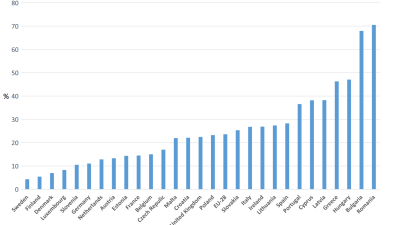Estimates of poverty for particular household types are significantly altered when account is taken of the distributional impact of public services, according to a new working paper prepared by Eurostat, the European Commission's statistical body.
The paper examines the impact of including the value of public healthcare, long-term care, education and childcare in estimates of income inequality and financial poverty in 23 European countries.
Key findings
- To account for the fact that the receipt of public services is associated with particular needs, a theory-based common equivalence scale is introduced – called the 'needs-adjusted European Union scale'. This adjusts for the fact that different public services are associated with needs profiles that differ from the profile exhibited by the EU scale for cash income.
- In particular, the scale recognises the fact that elderly people have relatively high needs for healthcare and long-term care, whereas children have high needs for childcare and education.
- Even though the ranking of countries by estimates of overall inequality and poverty proves to be only slightly affected by the adjusted scale, poverty estimates by household types are significantly affected – despite the fact, the researchers point out, that reliable information on the origin of income inequality and poverty is crucial for the design of welfare and tax systems.
- The calculations show that households with single adults below age 65 (with or without children) are exposed to a relatively high risk of poverty when needs for public services are accounted for. Elderly couples aged 65 and above are, however, found to be at low risk of poverty in most European countries. For elderly single adults aged 65 and above, the risk of poverty varies considerably between countries, depending on the level of public cash and in-kind transfers to elderly people.
Source: Rolf Aaberge, Audun Langorgen and Petter Lindgren, The Distributional Impact of Public Services in European Countries: 2013 Edition, Eurostat (European Union)
Link: Paper



 PSE:UK is a major collaboration between the University of Bristol, Heriot-Watt University, The Open University, Queen's University Belfast, University of Glasgow and the University of York working with the National Centre for Social Research and the Northern Ireland Statistics and Research Agency. ESRC Grant RES-060-25-0052.
PSE:UK is a major collaboration between the University of Bristol, Heriot-Watt University, The Open University, Queen's University Belfast, University of Glasgow and the University of York working with the National Centre for Social Research and the Northern Ireland Statistics and Research Agency. ESRC Grant RES-060-25-0052.






